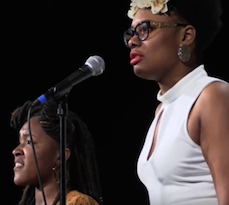WOKE
Internalisation and The Construction of ‘Black’
First, we must address two key questions: “How are we as black people, regardless of gender, presented within society?” “Why is it that we subconsciously internalise this?” It is no secret that we live under white patriarchy. The systematic tools of oppression are instilled within our society from the moment we are born; we are taught to compartmentalise ourselves into gender, religion, ethnicities, sexualities and race.
The term ‘black’ is simply a colour. Yet colonisation and its newly evolved globalisation has morphed the term black into a characteristic for all people of African descent and, in the case of Britain, all people of colour. Black is often synonymous with ‘cheap’, ‘criminal’ and the list can go on; however as Boyce teaches us the term ‘Blackness’ is a color-coded, politically based term … of definition which only has meaning when questions of racial difference and, in particular, white supremacy [is] deployed” (Boyce 1994: 7), this is particularly relevant when looking at black communities in western nations. Although ‘Blackness’ has politically resistant connotations the term ‘blacks’ has been constructed through colonialism as a tool for cognitive dissonance. Quite simply, whilst white colonialist were committing crimes against humanity upon African people they used the construction of ‘blacks’ to mentally and publicly justify the horrors they were inflicting upon human beings. Collins teaches that “under scientific racism, Blacks have been construed as inferior, and their inferiority has been attributed either to biological causes or cultural differences” (Collins 2009:85), these of course range from attributes like: ‘blacks’ having ‘thick skulls’ to being ‘mentally infantile’. The construction of ‘black’ is thrust upon ‘black’ people as Fanon writes about when he was around white people he “was responsible at the same time for [his] body, for [his] race, for [his] ancestors…[and his] ethnic characteristics” which at the time were “battered down by cannibalism, intellectual deficiency, fetishism, racial defects, slave-ships, and above all else…. “Sho’ good eatin’.” (Fanon:84-5). (footnote)The construction of blackness is vital to understanding how millennial black women have been subjected to colonial mechanisms without being consciously aware of how they manifest themselves.
The theories of internalisation are crucial to post-colonialism. Colonialism’s methods were very clear; keep the body strong (so that it can be exploited for labour) whilst keeping the mind psychologically weak (so that it can depend on the master). Whilst iconic figures like Fanon teach us how colonialism took control over the psyche of the oppressed, black feminist thinkers like Lorde teach us how these patriarchal ideologies are reinforced within black society. Lorde calls for us understand ‘that the master’s tools will never dismantle the master’s house’; she pleads for us to understand that as members of capitalist society, who were once used as capital, we must resist against the systematic structures that colonisation has left behind for the millennial black woman. Internalisation is/was forced upon people because of colonisation; empires did not rule by military and physical force alone. As McLeod writes colonialism was “insured by getting both colonising [and] uncolonized people to see their world and themselves in a particular way” (John McLeod 2010: 21-22). The very fact that we’re analysing texts in English supports the power of internalisation that imperial countries wield/ed.
To the ‘colonised’ internalisation is simply a response to the traumatic atrocities, systems and constructions of colonialism. In order to escape the cruel fate of the ‘black’, the ‘colonised’ wishes to embrace “the” civilised” ideas …But however hard the colonised tried[/s] to accept the education, values and language of …the white mask of civilisation” (John McLeod 2010:23) the ‘colonised’ will still never be accepted as an equal. The hope of attaining ‘whiteness’ is one of the many manifestations of internalisation because, like ‘Blackness’, “Whiteness is conceptualised” (Boyce 1994:6). To be ‘White’ is to be successful, happy and accepted within the society colonialism has crafted throughout the years. This internalisation of whiteness is especially crucial for women as it is known, even in present day, that when African women seek employment “they straighten their hair because if they go in with their hair natural or braided, they probably won’t get the job’ (Tate 1983,141)” (Collins 2009:100). It is this global, societal and individual internalisation of ‘blackness’ which weaves its way into politics, media and all mediums of art and subdues black women; it is the complexity of this oppression which magnifies the importance of staying ‘woke’.
Blackness & womanhood as a construction: Whitening
We internalise societies’ compartmental ideologies and as Lorde writes “we are Black women born into a society of entrenched loathing and contempt for whatever is Black and female. We are strong and enduring. We are also deeply scarred” (Audre 2007:8). This ‘entrenched’ loathing is especially relevant in the present day. As Jihad and Valentine’s ‘To be Black, Woman and Alive’ (2016) delves into the double standards of beauty which oppress black women and provoke internalisation; we are forced to look at how the toxic relationship between technology and media are factors in the slumber of black women’s identity.
Mainstream media has always promoted, advocated and pushed the image of the blonde white girl or, the more ‘diverse’, light skinned black woman. The millennial generation has been shown images of black women who are either mixed race or light skinned, thus solidifying the patriarchal ideology that light is right. As we have slowly moved towards a diversification in Hollywood, with movements like #OscarsSoWhite; we have been awoken to how prestigious organisations like the Oscars, and many other awards shows, are in control of what society finds acclaimed and beautiful. Logistically, if in 2017 we are unable to see positive representations of black women, namely those who are dark skinned, at all in media we must face the cruel cold truth: black women are boundaries of normality within society. “As “Others” of society who can never really belong, strangers threaten the moral and social order. But they are simultaneously essential for its survival because those individuals who stand at the margins of society clarify its boundaries. [black] women, by not belonging, emphasise the significance of belonging” (Collins 2009:77). As boundaries of belonging, millennial black women have either begun to internalise the construction of black womanhood (which will be clarified later), internalise ‘whiteness’ or, for those who’ve resisted, reject the system that creates such an ultimatum of identity. As we realise that the threads of oppression form a web, we are awoken to the important relationship that art and knowledge must have in order to keep the millennial black woman ‘woke’.
Blackness and femininity as a construction: internalising ‘black’ controlling images
Controlling images are tools, which construct the stereotype that is the ‘strong’, ‘sassy’, ‘angry’ black woman. In order to understand why these tools exist, we must first understand how and why they are implemented. Hollywood films recycle stereotypes of the black woman, “these controlling images are designed to make racism, sexism, poverty, and other forms of social injustice appear to be natural, normal, and inevitable parts of everyday life” (Collins 2009: 77). Collins teaches us why archetypes like the mammy, matriarch, welfare mother and jezebel exist. Firstly, the ‘Mammy’ is the dark skinned ‘caregiver’ and ‘nurturer’ who usually is ‘plump’; she is not sexually desirable. She is the character who is ‘content’ with being relegated to the background, designed to mask [the] economic exploitation of social class (King 1973)” (Collins 2009: 81). Contrastingly, the Black Matriarch is the origin to the ‘angry black woman’; independent, strong, and sassy she is presented as opportunistic, disrespectful and a nuisance to the white man. As white feminism threatened the patriarchal system in WW2, “the image of the Black Matriarch serves as a powerful symbol for both Black and White women of what can go wrong if White patriarchal power is challenged. Aggressive, assertive women are penalized- they are abandoned by their men, end up impoverished and are stigmatised as being unfeminine” (Collins 2009:85). Additionally, the ‘welfare mother’ is portrayed as a ‘leech’ of the welfare system, she usually has over four children, she is unemployed and uneducated, takes drugs and is sexually promiscuous. “The image of the welfare mother provides ideological justifications for intersecting oppressions of race, gender, and class. African-Americans can be racially stereotyped as being lazy by blaming Black welfare mothers for failing to pass on the work ethic” (Collins 2009:87). Finally, the ‘Jezebel’ , the original black ‘whore’, she has ‘daddy issues’, she is not emotionally stable, she is not domesticated and she has an “excessive sexual appetite [which] masculinizes her because she desires sex just as a man does” (Collins 2009:91). The “Jezebel’s function [is] to relegate all Black women to the category of sexually aggressive women, thus providing a powerful rationale for the widespread sexual assaults by White men typically reported by Black slave women (Davis 1981; D. White 1985)” (Collins 2009:89). These archetypes are integral to media representations of the black woman. Time and time again, these images are embedded into the black female psyche, which is why they are the foundation to the internalisation of white patriarchy.
Decolonising the mind: Awakening
Decolonisation is both knowledge and action. Recognising the structures, archetypes and systems which oppress black women is half the journey towards decolonizing the mind; the other is half is using this knowledge and taking on the ancient struggle for liberation. Part of that struggle is inspiring, awakening and mobilising others towards solidarity. As children of the millennium, we have the privilege to use a combination of technology, art and knowledge to awaken black women. Although mainstream media still systematically oppresses us, the freedom of social media allows us to promote black consciousness, beauty and solidarity in forms of art. Poetry has always been an artistic form of resistance which is why we have chosen to explore the different ways that poetry has been used; by exemplifying poetry in spoken word, chore-poem and song we aim to shed light on the suppressed images of black power within the millennium.
It is important to note that within black feminism there are often tropes of oppression towards different sexualities, religions and cultures, “as women, we must root out internalised patterns of oppression within ourselves if we are to move beyond the most superficial aspects of social change” (Audre 2007:122). By using _ social media as a tool for education we inspire others to recognise that we have all internalised colonial structures, archetypes and customs; simultaneously, we inspire others to try to resist against racial manifestations within their own cultures “for the master’s tools will never dismantle the master’s house” (Audre 2007:123).
As millennia’s with social media, we have the power to influence how our hidden stories are told. Since 2013 the Black Lives Matter movement has taken advantage of social media to expose how African Americans are being slaughtered by police officers; this monumental resistance has had global implications upon people of African descent. Throughout the world, people of African descent have been using social media to show how systematic racism manifests itself within their cultures from Black-Frenchness to Black-Hispanicness. These examples emphasise the importance of “dismantling … received geography” (Boyce 1994: 22) for it is important for us to understand that the fight for equality must be taken with open–mindedness, sensitivity and solidarity.
Looking forward
Since colonisation, white patriarchy has controlled perceptions of blackness, both in imperial and colonised countries, an acceptance of these archetypes is an acceptance of inferiority. To recognise that our difference is not our disadvantage, is to understand that integration is not a whitening of culture; instead it is an intentional and sensitive comprehension of what society has called the ‘other’, whilst understanding our own role within the oppression of others. Being black does not mean ignorance from others struggle; it is the sensitivity of understanding how oppression exploits every aspect of identity. Additionally, “as Black people… we must move against not only those forces which dehumanise us from the outside, but also against the oppressive values which we have been forced to take into ourselves” (Audre 2007: 6). This means that we must stay vigilant, in understanding that although we are oppressed, as a race, we can still obtain privilege; and it is with this privilege that we must help those who do not have the basic human rights of water, housing and education.
As children of the new millennium, we have subconsciously internalised ‘whiteness’; “we find ourselves having to repeat and relearn the same old lessons over and over … because we do not pass on what we have learned, or because we do not listen” (Audre 2007:117). We hear, but we do not listen. To listen is to learn, and it is often when we do not listen that we miss moments of oppression. As Hall writes: “ speaking against the construction of white representations of blackness as totalizing” (Hooks 1992:116) is vital to black self-identification because it is a reclaiming of power. Consequently, understanding the foundational aspects of society often causes a justified anger. Political icons like Lorde teach us that we “cannot hide [our] anger to spare … guilt, nor hurt feelings, nor answering anger; for to do so insults and trivialises all our efforts” (Audre 2007:130). Our anger is a driving force for equality, it reminds us of the inequality within society; it is a signifier of our humanity and a fuel for change. The passivity that society embeds into a culture is a trait for ignorance and complicity.
Look at your life, do you feel equal to your white privileged counterpart? Do you not feel the weight that the construction of Blackness has pushed upon you? Look at your career; can you honestly say that you are where you are despite your colour? If the answers were no, then you are partly woke to the systematic web of oppression that is upon black women. If the answer is yes then you, my dear sister, need to take a look into your psyche and decolonize your mind. We, as black women, are the symbols of resistance, not the boundary of normality, but the symbol of magic. Black girl magic. We are taking the baton from those strong black women who came before us, in order to enrich, inspire and motivate the future generations so that our children and grandchildren can know and feel the dream of equality.



